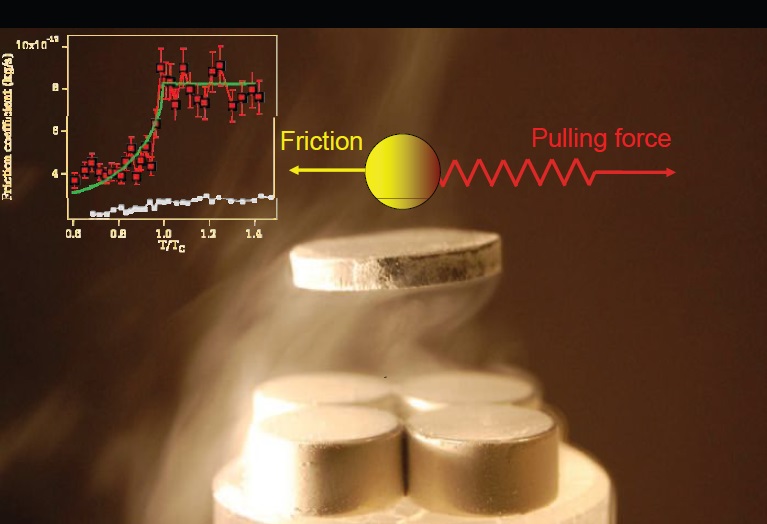Friction at a distance
Drs. Wilfred T. Tysoe & Nicholas D. Spencer | TLT Cutting Edge February 2012
Superconducting materials enable probing of out-of-contact friction mechanisms.

Researchers measured the friction using a silicon tip that was placed 0.5 nanometers from a very flat niobium sample.
TRIBOLOGY IS DEFINED AS “THE STUDY OF CONTACTING BODIES IN RELATIVE MOTION,” and we generally think of friction as occurring only when two surfaces touch. However, two closely spaced objects still interact, even if they are not in contact. This implies that energy can be dissipated when two closely spaced objects move relative to one another, producing a friction force, and such non-contact friction has indeed been observed.
There are two possible ways in which energy could be dissipated in this non-contact regime. The first is by electronic friction. When two different materials come close to each other, charge is transferred from one to the other. When they move relative to each other, this charge can fluctuate to produce a fluctuating current. Just as an electric current passing through a resistive wire loses energy to produce heat, when two surfaces move relative to each other, the fluctuating current produced also dissipates energy.
Second, the atoms in the two materials can also interact at a distance. When the two closely spaced surfaces move relative to each other, atomic vibrations are excited, and these motions also can dissipate energy. Since such vibrations in solids are known as phonons, this is known as phononic friction.
Although non-contact friction has been detected, which of the two described mechanisms dominate the friction is not well understood. In principle, this could be decided by measuring the properties of many different materials and by correlating their friction behavior with their electronic and vibrational properties.
Professor Ernst Meyer and his group at the University of Basel in Switzerland have used an alternative and more elegant approach. They measured non-contact friction using a niobium sample. Niobium is a superconductor, meaning that above the superconducting transition temperature, T
C (which is at 9.2 degrees Kelvin), it behaves like a resistive metal, while below this temperature, the resistance drops to zero. Thus, if friction is dominated by electronic effects, it should decrease dramatically as the temperature drops below 9.2 K.
They measured the friction using a silicon tip that was placed 0.5 nanometers from a very flat niobium sample. In order to maintain this small distance accurately, they measured friction by laterally exciting the tip like a pendulum at its resonant frequency (of 5.3 kHz). They then measured the time for the tip amplitude to decay when the driving frequency was switched off. The larger the friction force, the more rapidly the tip amplitude would decay.
By carefully measuring the friction force in small temperature steps below and above T
C, they found that the friction was much lower (by a factor of about four) below T
C than above, suggesting that electronic friction dominates.
They also measured the friction as a function of distance d from the surface for a temperature below (5.8 K) and above (13 K) T
C. Above T
C, where metallic behavior was found, the friction force is proportional to 1/
d, exactly what has been predicted for electronic friction. Below T
C, the friction force was found to decay as ~1/
d,
4 consistent with theories for phononic dissipation.
These non-contact friction forces are many orders of magnitude lower than contact friction so that engineers need not concern themselves with designing lubricants to mitigate their effects. However, they may become important in micro- and nano-electromechanical systems.
FOR FURTHER READING:
Kisiel, M., Gnecco, E., Gysin, U., Marot, L., Rast, S., and Meyer, E. (2011) “Suppression of Electronic Friction on Nb Films in the Superconducting State,”
Nature Materials,
10, pp. 119-122.
 Eddy Tysoe is a Distinguished Professor of Physical Chemistry at the University of Wisconsin-Milwaukee. You can reach him at wtt@uwm.edu
Eddy Tysoe is a Distinguished Professor of Physical Chemistry at the University of Wisconsin-Milwaukee. You can reach him at wtt@uwm.edu.
 Nic Spencer is professor of surface science and technology at the ETH Zurich, Switzerland. Both serve as editors-in-chief of STLE-affiliated Tribology Letters journal. You can reach him at spencer@mat.ethz.ch
Nic Spencer is professor of surface science and technology at the ETH Zurich, Switzerland. Both serve as editors-in-chief of STLE-affiliated Tribology Letters journal. You can reach him at spencer@mat.ethz.ch.